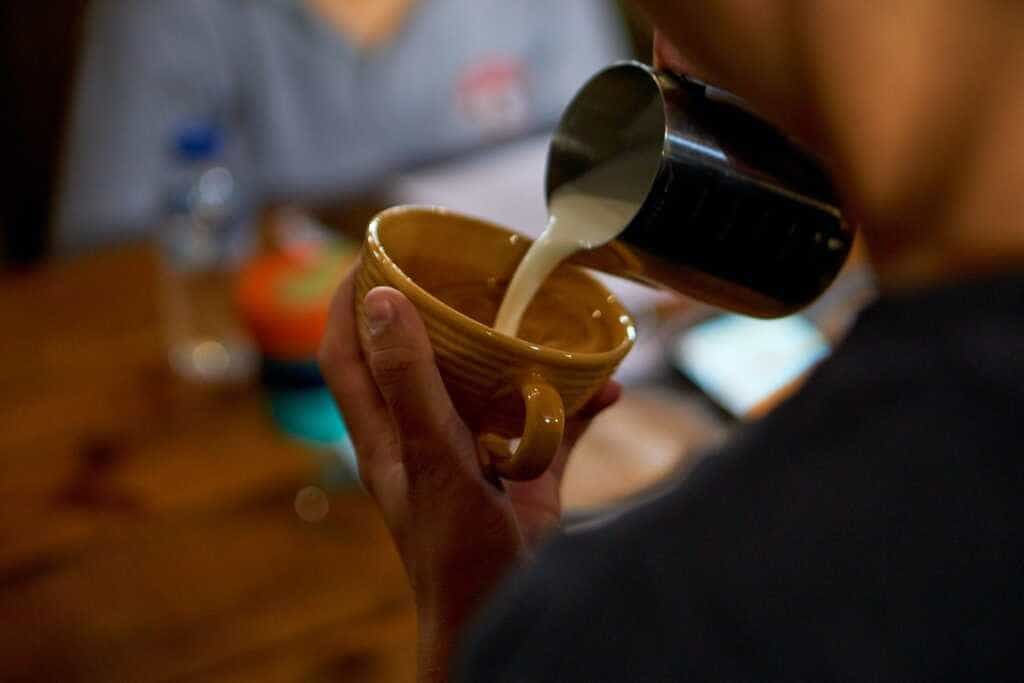
Have you ever gone through the process of brewing a perfect cup just to have it ruined when you add your creamer?
If the sight of white chunks and oily floating globules forming in your coffee is familiar, even though the creamer you used looked fine, you’ve probably got questions. Don’t worry, I’m here to help!
So, why is your coffee creamer chunky? It could be as simple as an expired product, or as complicated as the acidity in your beans negatively interacting with the acidity or base ingredients of your creamer.
To properly answer the question, we’re going to have to get specific, so if you want to know how to make sure your creamer stays smooth throughout the brewing process, keep reading!
Why is My Coffee Creamer Chunky
The base of every good cup of coffee is water, but if the water isn’t just right, it can throw your whole cup off…
Check Your Water Quality
The water you are using might look, smell, and even taste fine, but it could be slightly acidic or may contain impurities not filtered out in processing. While this doesn’t make the water unsafe to drink, it can cause problems if you want your coffee with milk or creamer.
If you want to test your water quality, you can order some PH testing strips online for very cheap. A simple dip of the strip into a clean glass of water will tell you all you need to know.
If impurities are your issue, you can solve the problem with a simple water filter.
Keep an Eye on Temperature
Another thing to keep an eye on is the temperature of your water. Water that’s reached the boiling point is hot enough to burn your coffee, and the creamer is even more sensitive to temperature.
As a general rule, dairy products shouldn’t be heated beyond a simmer unless you’re trying to make cheese. If you have a thermometer, make sure your coffee is between 180 F and 190 F before adding your cream. If you don’t have a thermometer, just wait a minute or two to allow your coffee time to cool.
High water temperature isn’t the only way to accidentally curdle your cream though, dairy products are also quite susceptible to temperature shock. Putting cold creamer from the fridge into a hot cup of coffee is a sure-fire way to create lumps.
To avoid this, it’s best to bring the creamer up to room temperature before you use it.
Look For The Expiration Date
Sometimes it’s obvious that your coffee creamer has gone off. Other times you won’t have any warning until it’s too late and the spoiled creamer is in your cup.
This can often be the case with non-dairy creamers, many of which are a mixture of oils, flavoring, whey, and sugar, giving them no obvious textural change or smell of curdling.
Curdling can also happen in dairy-based creamers before they even reach the expiry date. The lactic acid content of dairy cream builds up over time, so after the creamer has sat in your fridge for a while, the acidity of your coffee can be enough to curdle the cream as soon as it hits your cup.
To test the freshness of your creamer, without sacrificing an entire cup of coffee, brew just a bit more than you need and use it to test your creamer in a separate cup.
Know Your Creamer
It might seem obvious, but one of the most likely causes of chunky creamer is the creamer. The best way to eliminate this as one of the issues is to know your creamer.
For example, unless properly processed, non-dairy creamer products that use nut milk as a base are extremely likely to curdle. The acidity in most coffees is enough to cause curdling, and if the temperature is high enough, it is likely to separate or curdle.
If you are using powdered creamer, you might run into issues if you store it in the fridge. Not only does powdered creamer not typically require any sort of refrigeration, but storing it in the cold can add moisture, cause clumping, and hinder its ability to dissolve in your drink.
How to avoid undissolved and lumpy coffee when adding creamer
So now you know why your creamer might be clumping up in your cup, but how can you avoid it? Here are some of our best tips and tricks to ensure a smooth cup.
What’s the best temperature for adding creamer to your coffee?
The best temperature for adding creamer to coffee is at or below the simmering range of 180 F to 190 F. This temperature range is within the acceptable heat range for brewing coffee or can be reached by allowing your cup between 60 and 90 seconds to cool before you pour your creamer.
When should you add creamer to your coffee?
After your coffee is cool enough to avoid cooking your creamer, the amount of time you wait before adding the creamer is largely down to preference. You may not know that coffee with added creamer cools around 20% slower than unaltered black coffee. This happens for three major reasons:
1. Due to the dark color of black coffee, it releases heat at a higher rate than a lighter-colored coffee with cream or milk mixed in.
2. Adding creamer increases the viscosity of your coffee, causing the drink to evaporate at a slower rate, and retain more of its heat. As a result of the Stefan-Boltzmann law, which states that hotter surfaces with more energy to offload radiate heat faster.
So, what does this mean for you? If you prefer your coffee on the cooler side, you should let your coffee sit for a few minutes after brewing before you add in your creamer or you might be waiting a long time to drink it.
What’s the best way to mix creamer into your coffee?
The best way to mix creamer into coffee is to put the creamer into your mug first, then pour your coffee into it. This is a method used in restaurants and allows the coffee to do most of the work for you and save you from dirtying a spoon or other kitchen tool.
Tools you can use to mix creamer into coffee
If you prefer not to use the cream-first pouring method, there are plenty of simple tools that can help you thoroughly mix your creamer into your coffee. A simple teaspoon, a stir stick, or chopstick, or even a tiny whisk will get you great results every time.
How much creamer should you use in coffee?
The amount of creamer you want to use is largely a personal preference as it affects taste, texture, and temperature.
One thing to keep in mind is that most liquid or concentrate coffee creamers have a shelf life of only two weeks in the refrigerator after opening.
If you aren’t a regular coffee drinker, you may wish to use a little more in each cup to avoid waste.
How can you tell if coffee creamer has gone bad?
Determining if your coffee creamer has gone off is done differently depending on the type of creamer you’re using. For liquid and concentrate creamers, keep an eye out for lumps, thickening, a sour smell, or a change in taste.
Always check the best by date, and dispose of anything sitting open in your fridge for
two weeks or more. If you aren’t sure about the freshness of your creamer, you can taste a small amount with a teaspoon to make your final decision.
Powdered creamer is much more stable and has an extended shelf life at room temperature, but it will still go off with time. Watch out for textural changes, clumping, moisture, and mold development.
How long can coffee creamer sit without refrigeration?
The longevity of your coffee creamer at room temperature depends on several factors including the packaging, storage method, type of creamer, and the processing it went through in manufacturing.
Many liquid or concentrated creamers are full of preservatives that allow them to remain fresh while unrefrigerated until the seal is broken.
If a liquid or concentrated creamer has never been opened but is passed its best by date, it’s best to throw it out. Small sealed cups of dairy and non-dairy creamers are a common sight on restaurant tables.
Restaurants generally store these creamers in the fridge overnight to maximize freshness, but these creamers are safe to be left out for long periods and have a shelf life of more than six months. Their airtight packaging is the main contributor to their longevity.
Powdered coffee creamer can store at room temperature for 18 to 24 months, but take care to store it properly. The creamer should never be exposed to heat and should be kept in a sealed container.
What is the best quality coffee creamer?
Nestle Coffee-Mate Liquid Creamer

Nestle’s Coffee-Mate Liquid creamer is easily one of the most popular and recognizable liquid creamers on the market. It offers a consistent, high-quality product that can be found in any store, or on Amazon, and is available in more than 20 flavors, including seasonal favorites like pumpkin spice and peppermint mocha.
International Delight
International Delight is another top-notch liquid coffee creamer that can be found at any grocery store (Check the price on Amazon). Like Coffee-Mate, the company offers more than 20 unique flavors, plus seasonal favorites, but it also offers sugar-free versions of its most popular flavors, making it a great option for anyone trying to cut down on their intake of sweets.
Califia Farms Unsweetened Vegan Creamer

Our last suggestion is something a little different, while Califia Farms Creamer may not be available at every grocery store (Link to Amazon), it offers a high-quality, unsweetened, vegan-friendly alternative to standard coffee creamers available in six flavors.
The creamer is made with a 50/50 blend of Almond Milk and Coconut Cream that offers the same mouth feel as traditional creamers, without using dairy fat, oils, soy, or carrageenan.
Final Thoughts
If you’ve made it this far, congrats! You are officially an expert on coffee creamer, and you’ll never have a lumpy cup again.
If you liked this article, why not check out some of our others and become even more of a coffee buff? Do you have any tips or tricks we didn’t cover here? Please share them with us in the comments!
Finally, why not share this article on social media? Together we can put an end to chunky coffee creamer and save countless cups of coffee from a terrible fate.
